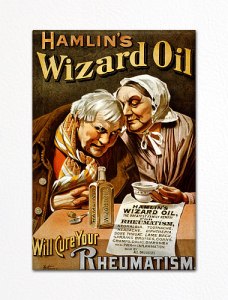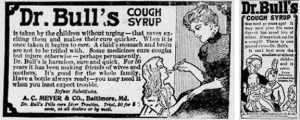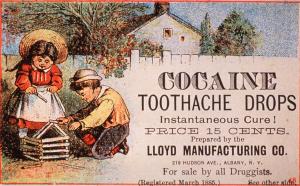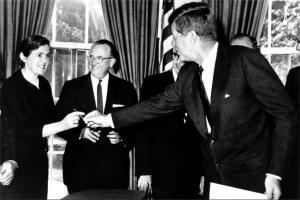A “quack” is someone who pretends to be a physician or who claims to have medical knowledge that they do not possess. They often promise quick results or painless cures for serious conditions. They often advise patients to use specific devices or medicines with secret formulas. Many advertised their products in newspapers and drug stores or sold them through the mail. Others traveled from town to town, selling their products.
Quack medicine popular in the 19th century for several reasons. For many patients, traditional medicine at the time was unable to treat their illness, or the treatments was painful, expensive, or risky. Medicine at this time relied heavily on bleeding or powerful herbal medications that purged the patient. In addition, there was a lack of regulation in medical training and treatment that made it easy for people with little or no training to call themselves doctors.

The 1906 Pure Food and Drug Act
Beginning in the 1870s, a number of states passed general food safety laws, but very few of them prevented the sale of harmful or worthless medicines. By 1906, more than 100 food and drug bills had been introduced in the U.S. Congress, but none had been passed.
Dr. Harvey Wiley, chief chemist of the U.S. Department of Agriculture from 1883 to 1912, was one of the most active proponents for federal laws governing food and drug safety. Wiley’s efforts helped lead to the 1906 Pure Food and Drug Act, which prohibited transportation of impure or contaminated food and drugs in interstate commerce and required truthful labels.
In particular, the law mandated that medicines that contained alcohol, morphine, opium, cocaine, heroin, cannabis, alpha or beta eucaine, chloroform, choral hydrate, acetanilide, or any of their derivatives, must have their quantity or proportion listed on the packaging. This was the first major strike against the patent medicine industry.

This medicine was 65% alcohol mixed with oils of sassafras, clove, and camphor. Its traveling salesmen boasted that there was no sore it couldn’t heal, no pain it won’t subdue. It could be used topically or ingested. Under the 1906 Pure Food and Drug Act, the company was fined $200 and forced to remove the claim that it cured cancer.

At the end of the 1800s, new laboratory techniques allowed chemists to test food and drugs to determine their component ingredients and strength. In general, the expanding use of the laboratory led to new understandings of disease and the action of drugs.
In 1905, journalist Samuel Hopkins Adams wrote 11 revealing, investigative articles for Collier’s magazine about the patent medicine industry. These widely read reports helped provide additional support to finally pass legislation to protect consumers.
Harrison Narcotics Act, 1914
Part of the problem with patent medicines was that strong opiates and cocaine were sold over the counter to the public. Physicians were unaware of their highly addictive nature. In the late 1800s and early 1900s, cocaine and opium were used casually and often added to bottled medicines and beverages.
Use of these drugs began to decline around 1914, when 46 states had passed regulations on the use of cocaine and 29 states had laws against the use of opium, morphine, and heroin. The 1914 Harrison Narcotics Tax Act was the first national law regulating the sale and purchase of these drugs. Manufacturers and distributers had to be registered with the federal government and pay a tax. It was not legal for anyone who had not paid these taxes to be in possession of the drugs.

1938 Federal Food, Drug and Cosmetic Act
After the 1906 Act, the FDA continued to advocate for a stronger role in protecting citizens against harmful and misleading medicines and medical devices. Their next big legislation was the 1938 Federal Food, Drug and Cosmetic Act. It was finally passed after a major disaster with a sulfanilamide medication that caused more than 100 deaths in 15 states. The major improvements are:
- The FDA regulates cosmetic and therapeutic medical devices.
- Drug manufacturers must provide scientific proof that new products are safe to use before putting them on the market.
- The FDA has the authority to inspect factories that produce medical products.
- The FDA must approve most drugs and some medical devices.
- The FDA has the authority to seize illegal medical devices and bring charges against those involved.
Attempts to stop quackery
The American Medical Association
The movement against quacks in the United States was aided by the formation of the American Medical Association in 1847. By the 1880s, anyone could purchase fraudulent medical degrees from one of several “diploma mills” without ever attending a day of medical school. Putting an end to diploma mills was one of the AMA’s objectives during the early twentieth century.
Growth of the FDA
The 1938 Federal Food, Drug and Cosmetic Act has been amended many times to strengthen regulation of medical treatments. A major change came in 1962 when the Kefauver-Harris or Drug Efficacy Amendment mandated that all new drug applications demonstrate that it is effective for the stated purpose. It also established the pre-market testing standard as the randomized, double blind controlled clinical trials.
In the past 35 years, there have been 24 additional amendments to address concerns in the rapidly changing food and drug industries. Major changes for medicine included:
- mandatory reporting of death, illness, or injury for medical devices and dietary supplements (1990 and 2006)
- establishing labeling and safety standards for dietary supplements (1994)
- improving research on the safety and efficacy of pharmaceuticals for children (2002)
- conducting post-market reviews of medical devices (2002)
After signing the Kefauver-Harris Amendment on October 10, 1962, President John F. Kennedy presented a pen to Dr. Frances Kelsey. Dr. Kelsey was the FDA medical officer that refused to license the drug thalidomide for use in the United States, citing the lack of clinical evidence of its safety. In Europe, the drug was marketed as a safe sleep aid and also eased morning sickness in pregnant women. In 1961, European researchers finally linked the drug to 10,000 cases of serious birth defects and it was taken off the market. Because it was not licensed in the U.S., there were only 17 cases of birth defects reported. The tragedy encouraged the passage of the Kefauver-Harris Amendment.



[…] trouve des références à cet épisode le site du Rose Melnick Medical Museum, La collection en ligne du Hagley Museum and Library permet au visiteur intéressé […]
[…] trouve des références à cet épisode le site du Rose Melnick Medical Museum, La collection en ligne du Hagley Museum and Library permet au visiteur intéressé […]
We are interested in purchasing rights to the “Cocaine Tooth Drops” image for an upcoming campaign we are doing for our client Museum of Science Boston.
Please let me know where I can get more information on the owner of the image.
Thanks.
I’m not sure who owns it. One source listed Barcroft Media as an owner, but I can’t confirm that.